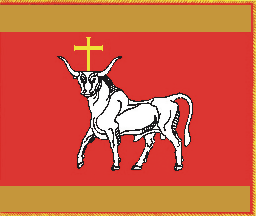
by Rob Raeside, 15 May 2001

Last modified: 2004-07-31 by dov gutterman
Keywords: lithuania | kaunas |
Links: FOTW homepage |
search |
disclaimer and copyright |
write us |
mirrors
See also:
Kaunas city flag (both sides) is based on images at <www.kaunas.lt>.
Virginijus Misiunas, 15 May 2001
Kaunas (interbellum capital): City flag seen on the old Town
Hall. The narrow top and bottom stripes were bright yellow,
in fact the same colour as the cross on top of the bull's
head.
Jan Mertens, 15 August 2003
Description of the flag of Kaunas city: The flag of Kaunas
city, designed by A. Lapienis, was adopted on April 19, 1999.
There is two type of Kaunas flag: representative, which is kept
in the office of Kaunas mayor and ordinary, which is used in
holidays, celebrations, hoisted by Municipality, City Hall etc.
Representative flag (dimension is 120x144 cm) consist of three
horizontal bands – golden, red, and golden. Front of the
flag is charged with silver wild ox. Back of the flag is charged
with silver symbols of Saint Nicolas, patron of the city:
bishop’s mitre, letter M, and three spheres. There is an
inscription "Mylekime teisuma" (Love justice) on both
sides of symbols. The cloth has golden-red cord edging on three
sides. The spear-head imprinted with the bronze head of wild ox
with cross and tied with golden-red cord.
Ordinary flag (dimension is 102x155) consist of three horizontal
bands – golden, red, and golden. Both sides of the flag are
charged with wild ox. Using of the flag is not regulated. The
ordinary flag is used to popularize the city and its symbols
among the visitors and the citizens of Kaunas. Description of the
flag based on text in Lithuanian from the official site of Kaunas
municipality (<www.kaunas.lt>).
Audrius Slapsinskas, 24 November 2003
More details on the history of the city are available on the municipal website <www.kaunas.lt>. Kaunas is today the second lagest city in Lituania, with 381,000 inhabitants (2001 census). The area of the municipality is 15,700 ha. The old city of Kaunas was built on the confluency of the rivers Niemen and Neris. Ir was mentioned for the first time in annals dated 1361. In the XIIIth century, a brick castle was built to protect the city from the Teutonic Knights and the city was fortified. In 1408, great duke Vytautas granted the city municipal rights. Kaunas became a wealthy trade center and river port, which traded with the cities of western Europe. In 1444, the merchants of the Hanseatic League opened a counter in Kaunas, which was active until 1532. During the XVIth century, the first school, hospital and pharmacy were built in Kaunas. At the end of the XVIth century, Kaunas was the best or